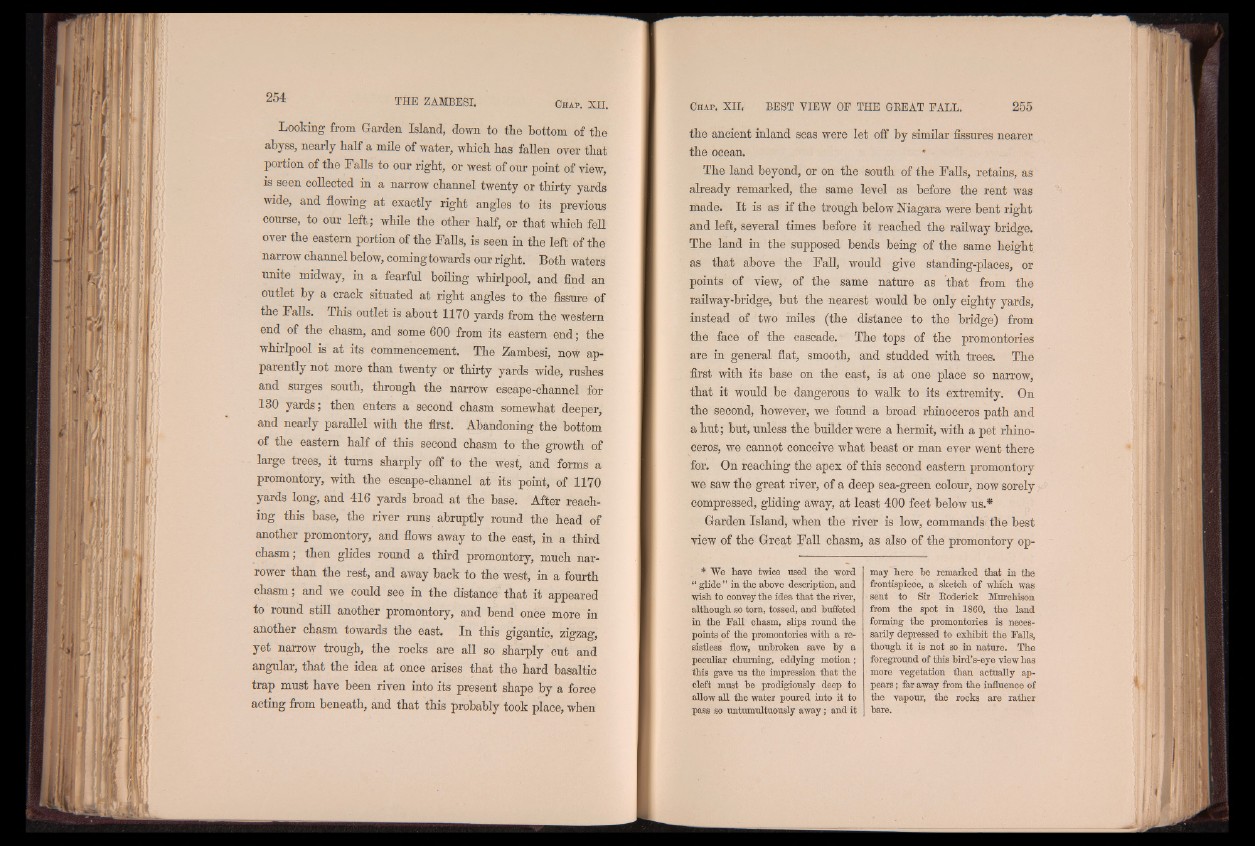
Looking from Garden Island, down to the bottom of the
abyss, nearly half a mile of water, which has fallen over that
portion of the Falls to our right, or west of our point of view,
is seen collected in a narrow channel twenty or thirty yards
wide, and flowing at exactly right angles to its previous
course, to our left; while the other half, or that which fell
over the eastern portion of the Falls, is seen in the left of the
narrow channel below, coming towards our right. Both waters
unite midway, in a fearful boiling whirlpool, and find an
outlet by a crack situated at right angles to the fissure of
the Falls. This outlet is about 1170 yards from the western
end of the chasm, and some 600 from its eastern end; the
whirlpool is at its commencement. The Zambesi, now apparently
not more than twenty or thirty yards wide, rushes
and surges south, through the narrow escape-channel for
130 yards; then enters a second chasm somewhat deeper,
and nearly parallel with the first. Abandoning the bottom
of the eastern half of this second chasm to the growth of
large trees, it turns sharply off to the west, and forms a
promontory, with the escape-channel at its point, of 1170
yards long, and 416 yards broad at the base. After reaching
this base, the river runs abruptly round the head of
another promontory, and flows away to the east, in a third
chasm; then glides round a third promontory, much narrower
than the rest, and away back to the west, in a fourth
chasm; and we could see in the distance that it appeared
to round still another promontory, and bend once more in
another chasm towards the east. In this gigantic, zigzag,
yet narrow trough, the rocks are all so sharply cut and
angular, that the idea at once arises that the hard basaltic
trap must have been riven into its present shape by a force
acting from beneath, and that this probably took place, when
the ancient inland seas were let off by similar fissures nearer
the ocean. *
The land beyond, or on the south of the Falls, retains, as
already remarked, the same level as before the rent was
made. I t is as if the trough below Niagara were bent right
and left, several times before it reached the railway bridge.
The land in the supposed bends being of the same height
as that above the Fall, would give standing-places, or
points of view, of the same nature as that from the
railway-bridge, but the nearest would be only eighty yards,
instead of two miles (the distance to the bridge) from
the face of the cascade. The tops of the promontories
are in general flat, smooth, and studded with trees. The
first with its base on the east, is at one place so narrow,
that it would be dangerous to walk to its extremity. On
the second, however, we found a broad rhinoceros path and
a hut; but, unless the builder were a hermit, with a pet rhinoceros,
we cannot conceive what beast or man ever went there
for. On reaching the apex of this second eastern promontory
we saw the great river, of a deep sea-green colour, now sorely
compressed, gliding away, at least 400 feet below us.*
Garden Island, when the river is low, commands' the best
view of the Great Fall chasm, as also of the promontory op-
* We have twice used the word
“ glide in the above description, and
wish to convey the idea that the river,
although so tom, tossed, and buffeted
in the Fall chasm, slips round the
points of the promontories with a resistless
flow, unbroken save by a
peculiar churning, eddying motion;
this gave us the impression that the
cleft must be prodigiously deep to
allow all the water poured into it to
pass so untumultuously away; and it
may here be remarked that in the
frontispiece, a sketch of which was
sent to Sir Roderick Murchison
from the spot in 1860, the land
forming the promontories is necessarily
depressed to exhibit the Falls,
though it is not so in nature. The
foreground of this bird’s-eye view has
more vegetation than actually appears
; far away from the influence of
the vapour, the rocks are rather
bare.